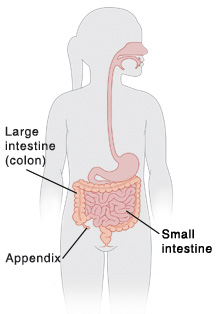When Your Child Has Appendicitis
When Your Child Has Appendicitis
The appendix is a small, hollow piece of tissue attached to the colon (large intestine). An infection of the appendix is called appendicitis. Surgery is most often needed right away to remove an infected appendix. Your healthcare provider will tell you more about your child’s condition and what your choices are.
The appendix
Waste moves through the colon and passes in and out of the appendix. In some cases, waste can be trapped inside the appendix. When this happens, an infection can form. An infected appendix can swell and then burst (rupture). This can be very dangerous. This is why surgery is often done right away to remove the appendix before it bursts. Sometimes if the appendix has burst and a pocket of infection has formed (abscess) this will be drained and antibiotics given for some time (can be weeks) before the appendix is removed.
What are the symptoms of appendicitis?
Symptoms can appear very quickly. They may happen over a period of hours to 1 or 2 days. They may include:
Pain that starts in the center of the belly and moves to the lower right side
Pain that gets worse with walking
Nausea or vomiting
Low appetite
Fever
Fatigue (tiredness)
Diarrhea (loose, watery stool) or constipation (hard, dry stool)
How is appendicitis diagnosed?
An exam will be done to locate the source of your child’s pain. Tests may be done if needed. These include blood tests or urine tests. A test that takes a picture of the belly may be done. This might be an X-ray, ultrasound, or CT scan.
How is appendicitis treated?
Surgery is done to take out the appendix. This is called an appendectomy. It may be done in 1 of 2 ways:
Open surgery. A single incision 2 or 3 inches long is made in the lower right part of the belly. If the appendix has ruptured, the incision may need to be bigger.
Laparoscopic surgery. Between 1 and 4 small incisions are made in the belly. A laparoscope (a thin, lighted tube with a camera) is put through one incision. It shows the inside of the belly on a screen. Tools are put into the other incisions.
The incision(s) will be closed with sutures or staples. A tube may be inserted for a short time. This is done to drain fluid. If the appendix has ruptured, the incision may be left open. This lets it drain more easily. It may heal on its own. Or it may be closed 4 or 5 days later.
Your child’s recovery
Your child will likely stay in the hospital for 1 to 2 days. If the appendix has ruptured, the stay may be a week or more. During this time:
Your child will be given medicine to help relieve pain.
Fluids may be given through an intravenous (IV) line.
Antibiotics may be given to prevent or fight infection.
Your child will be given only liquids at first. This is to let the colon heal. Solid food is then slowly started again.
Your child should avoid heavy lifting, contact sports, and rough play for 3 to 4 weeks. Once the incisions heal, your child can go back to all activities.
Call the healthcare provider
Call your healthcare provider if your child has any of the following:
Signs of infection at the incision site, such as swelling, drainage, worsening pain, or unusual redness
Fever of 100.4°F (38°C) or higher, or as directed by your healthcare provider
Worsening belly pain
Severe diarrhea, bloating, or constipation
Nausea or vomiting
Updated:
August 16, 2018
Sources:
Acute Appendicitis — Appendectomy or the “Antibiotics First” Strategy. Flum D. The New England Journal of Medicine. 2015;372(20):1937-43., Acute appendicitis in children: Clinical manifestations and diagnosis. UpToDate, Acute appendicitis in children: Diagnostic imaging. UpToDate, Acute appendicitis in children: Management. UpToDate
Reviewed By:
Freeborn, Donna, PhD, CNM, FNP,Image reviewed by StayWell medical illustration team.,Lehrer, Jenifer, MD